Writing Rests #1 – Breve Rest
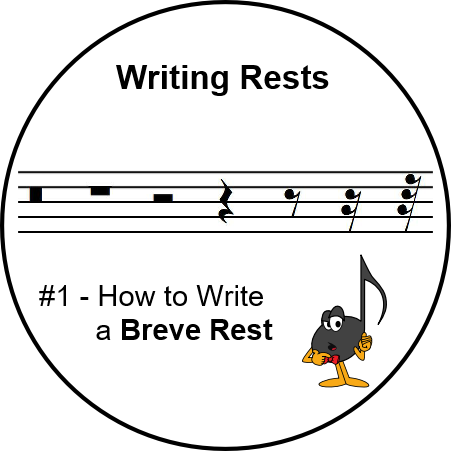
Welcome to the Ultimate Music Theory Blog Series on How to Write Rests. In this Blog, we are going to explore How to Write a Breve Rest.
A Breve Rest is a very specific rest that is used only for a whole measure of silence in 4/2 Time. (Sorry that I have to write the Time Signature "4/2" as a fraction, but this program will not let me insert the proper Time Signature.)
When we teach Rests, a Whole Rest is used to indicate a Whole Measure of Silence in every Time Signature except in 4/2 Time. In 4/2 Time, a double whole rest is required. This type of rest is called a Breve Rest.
The Essential Dictionary of Music (Alfred's Publication) indicates that the term Breve is pronounced as "BREH-ve, brev".
The term "Breve" originally referred to the shortest note value. Since the 16th Century though, it switched to referring to the longest value - two whole notes (or two whole rests).
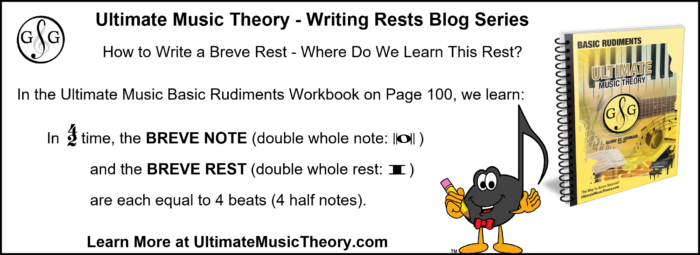
Writing Rests Blog #1 - Breve Rest
Rests are an important part of music. I like to discuss with my Students that sound and silence are both a part of their music.
The Dolmetsch Online Music Theory Dictionary identifies rests as periods of silence in music.
A Breve Rest is also called:
- a double-whole rest (in American)
- a pausa di breve (in Italian)
- a pause de brève or a silence de brève (in French)
- a doppel Pause (in German)
- a pausa de breve or a silencio de breve (in Spanish)
As Students start to learn about rests, we introduce that a Whole Measure of Silence = a Whole Rest. (Page 31 in the Ultimate Music Theory Prep 2 Rudiments Workbook) Students at this level are only studying Simple Time with a Quarter Note as the Basic Beat. So, we do not introduce this exception to the Whole Rest Rule!
When a Student progresses to the Basic Rudiments Workbook, they learn that a Basic Beat can also be a Half Note, a Quarter Note, or an Eighth Note. Therefore, in 4/2 Time, a Whole Measure of Silence = a Breve Rest.
Compound Time, and Time Signatures with a 16th note as the Basic Beat is introduced in the Ultimate Music Theory Intermediate Rudiments Workbook.
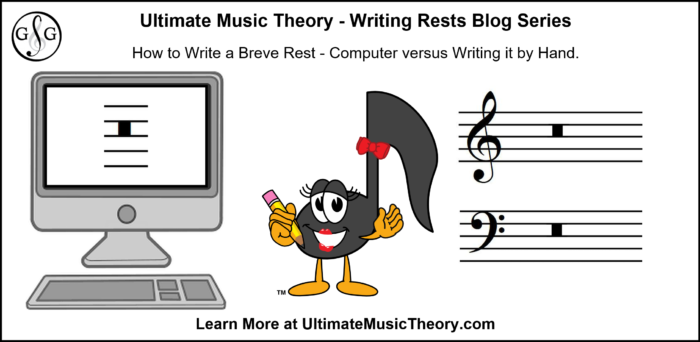
The Norton Manual of Music Notation states that "Rests should be drawn to resemble those found in engraved music as closely as possible".
Engraved Music today is typically music that is written using a Computer Program. It is pretty easy to write a Breve Rest by hand so that it looks just like the Breve Rest that is written using a program like Finale.
How to Write a Breve Rest by Hand
A Breve Rest is a tall, thin rectangle that is written to fill Space #3. If you compare the width of the Breve Rest, it would be thinner than the inside of a Whole Note.
When I mark Theory, a common Boo-Boo is when a Breve Rest is written to be the same length as a Whole Rest. This is incorrect.
Use your Ultimate Music Theory Student Whiteboard to practice drawing that tall, thin rectangle. I describe it as looking like a Whole Rest that has been tipped on its side.
If the Breve Rest is written too "wide and thick", then it is easy to mistake it for a Whole Rest that has been written too "thick".
Work with your Students so that they learn to write this Rest correctly. This is important! "Close Enough" is not appropriate in Theory.
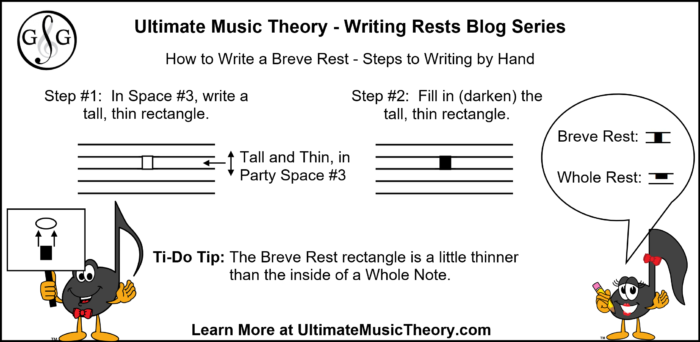
How To Write a Breve Rest Without a Staff
When a Breve Rest is written without a staff, we write a small line above it and a small line below it. This identifies that the Rest is written to fill the area between 2 Staff Lines.
Here is a fun little rhyme that I teach my Students: "When you are a Rest, Party Space #3 is the Place to Be"! As you continue reading through my Writing Rests Blog Series, you will discover that all rests have a foundation in Space #3. (So, we call it "Party Space 3".)
It doesn't matter whether you are writing in the Treble or Bass, or in ANY of the 5 C Clefs, a Breve Rest is always written in Space #3.
So, when we write the Breve Rest without the lines and spaces of a staff, we add the small line above and below to give the rest a placement.
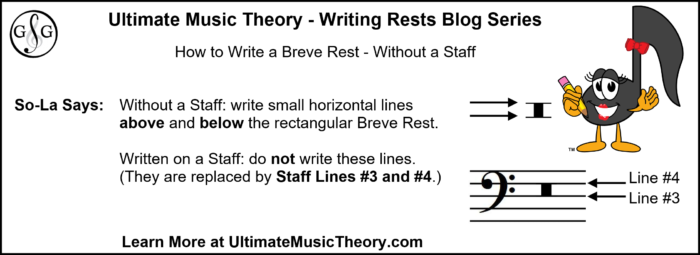
The Writing Rests Blog Series
This Blog Series will be focusing on how to write rests, and not on WHAT rest to write. Each Blog also has a matching Worksheet (with a corresponding Answer Sheet). To get these resources, join the Ultimate Music Theory Membership!.
As Teachers, we need to be able to understand why we use the rests that we do. I know that I often questioned why my answer was considered incorrect. When I started learning the Ultimate Music Theory Program, so many of my questions were answered! This made such a difference in my teaching.
I strongly recommend watching the "Teach Rhythm and Rests" online Course. If you don't learn something new, you will at least have reinforced your knowledge. However, I bet (just like me) that you will realize that you didn't know something! Those "Ah-Ha" moments of learning are so exciting.
Thank you for reading! I look forward to seeing you in the Writing Rests Blog Series #2 - The Whole Rest Blog.
Ultimate Music Teachers Membership
♪ LEARN ♪ PLAN ♪ TEACH ♪ GROW
The One & ONLY Ultimate Music Teachers Membership
To Become A UMT PRO!
Your Success Path Starts Here - Go To TeachUMT.com Today!
Keep on Learning... With a Smile and a Song!
Shelagh McKibbon-U'Ren


